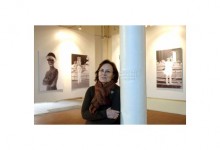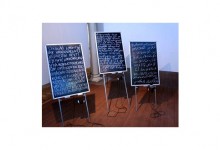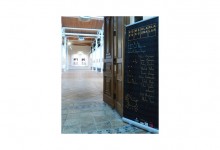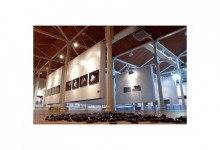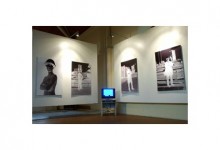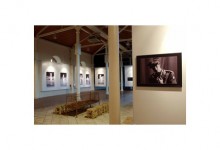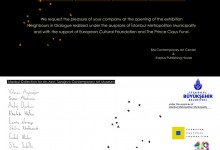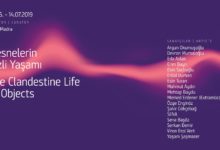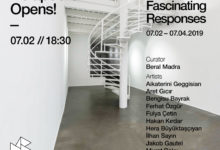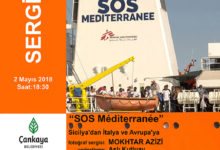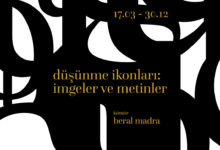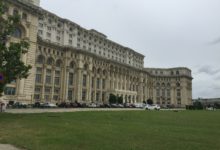- BM-ALL PHOTOS:MUHSIN AKGÜN
- DİLEK WINCHESTER
- ENTRANCE TO THE EXHIBITION
- GENERAL VIEW WITH KHALED HAFEZ
- SHLVA KHAKHANASHVILI
- SHLVA KHAKHANASHVILI, WAFAA YASIN, KHALED HAFEZ
www.neighboursindialogue.net
NEIGHBOURS IN DIALOGUE
Istanbul Collection for Ars Aevi, Contemporary Art Museum, Sarajevo
10–31 March 2007
Feshane-i Amire, ISTANBUL
CURATOR: Beral Madra
ARTISTS: Steve Sabella ( Jerusalem); Wafaa Yasin ( Galilee); Senan Askerov (Baku); Lamia Joreige (Beirut) ; Vahram Aghasyan (Yerevan); Khaled Hafez ( Cairo); Shalva Khakhnasvili (Tbilisi – Paris); Farhad Moshiri (Teheran); Dilek Winchester (İstanbul); Xurban (Istanbul-İzmir-New York) and Andrej Djerkovic (Sarajevo).
“Neighbours in Dialogue” is realised under the patronage of Istanbul MetropolitanMunicipality and with the support of the European Cultural Foundation and Prince Claus Foundation.
The art works are going to be donated to Arsa Aevi, Contemporary Art Museum, Sarajevo. Exhibitions for this purpose have been realized in Milan, Prato, Ljubljana, Venice, Vienna and Bologna between 1992 and 2003. http://www.arsaevi.ba
The organizers of this project BM Contemporary Art Center (www.btmadra.com ) and Korpus Publications aim to support the cultural relations, artistic communication, and collaboration in between the art experts and artists from South Caucasus, Middle East and East Mediterranean.
The concept of the exhibition is based on the book “Neighbours in Dialogue” edited by Beral Madra and Ayşe Orhun Gültekin, published in English by Norgunk Publications in May 2005, Istanbul. The book was launched in the international meeting “Venice Agendas” and the authors of the book were invited to Venice for the related forum during the 51st Venice Biennale, June 2005. The Turkish version of the book is published for the Istanbul exhibition. Leyla Akundzadeh, Ruben Arevshatian, Saleh Barakat, Kamal Boullata, Salwa Mikdadi and Nermin Saybaşılı, who contributed to the book invited the artists.
KOMŞULARLA KONUŞMALAR
SARAYBOSNA ARSAEVİ KOLEKSİYONU İÇİN ÇAĞDAŞ SANAT SERGİSİ
Feshane-i Amire, Istanbul
10 -31 MART 2007
KÜRATÖR: Beral Madra
SANATÇILAR: Steve Sabella (Kudüs); Wafaa Yasin (Galilee); Senan Askerov (Bakü); Lamia Joreige (Beyrut) ; Vahram Aghasyan (Erivan) ; Khaled Hafez (Kahire); Shalva Khakhanasvili (Tbilisi-Paris); Farhad Moshiri (Tahran); Dilek Winchester (İstanbul); Xurban (İstanbul-New York)
İstanbul Büyükşehir Belediyesi himayesinde European Cultural Foundation (ECF) ve Prince Claus Vakfı destekleriyle gerçekleştirilen Komşularla Konuşmalar Sergisinin yapıtları Saraybosna’daki Ars Aevi Çağdaş Sanat Müzesi Koleksiyonu’na bağışlanacaktır.
Ars Aevi Koleksiyonunu oluşturmak için 1992 – 2003 yılları arasında, Milano, Prato, Ljubljana, Venedik, Viyana ve Bologna kentleri sergiler düzenlemiştir. 2003 ‘den bu yana İstanbul, Zagreb, Selanik, Atina, Ghent, Frankfurt ve Bonn’dan koleksiyonların gelmesi beklenmektedir. http://www.arsaevi.ba
Güney Kafkasya, Ortadoğu ve Doğu Akdeniz’den sanatçılar arasında iletişim ve işbirliğini desteklemeyi, bölge ülkeleri arasında kültürel alış verişe katkıda bulunmayı ve İstanbul odaklı bir sanat platformunu canlı tutmayı amaçlayan serginin yapımcılığını BM Çağdaş Sanat Merkezi ve Korpus Kültür Sanat Yayıncılık üstlenmiştir.
Serginin önemli bir özelliği de Norgunk Yayınevi tarafından Mayıs 2005’te Beral Madra ve Ayşe Orhun Gültekin’in editörlüğünde İstanbul’da İngilizcesi yayınlanmış olan ‘Neighbours in Dialogue’ (Komşularla Konuşmalar) başlıklı kitaba dayanan bir içeriğe sahip olmasıdır. Haziran 2005’te kitap, 51.Venedik Bienali’ne paralel bir etkinlik olarak düzenlenen ‘Venice Agendas’ toplantılarının açılışında sunulmuş, üç günlük açıkoturumun konusu olmuş ve yazarlar Venedik’e davet edilmiştir. Sergi dolayısıyla kitabın Türkçesi yayınlanacaktır. Kitaba katkıda bulunan yazarlardan Leyla Akundzadeh, Ruben Arevshatian, Saleh Barakat, Kamal Boullata, Salwa Mikdadi ve Nermin Saybaşılı sanatçıların seçimini gerçekleştirmiştir.
BROCHURE TEXT FOR NEIGHBOURS IN DIALOGUE
10-31 MARCH, FESHANE-I AMIRE, ISTANBUL
Since the 1990s we have witnessed the emergence of a new dialogue and exchange of ideas among the arts communities of the countries of the Southern Caucasus, the Middle East and the Eastern Mediterranean; it is our sincere hope that this essential process in the making of current art will continue. In spite of ongoing adverse political and economic developments in the region, the practice of art, art criticism, general critical theory and local art events are continuing and intensifying with the support of a regional network and mutual agreements.
The existence within this territory of a complex multilingual and multicultural galaxy composed of a variety of modernisms and postmodernisms with various forms of expression and differing discourses renders these contemporary art scenes even more prolific and attractive. In addition, there is a desire and even a sense of urgency to remap the contemporary cultural environment in a manner parallel to the rapid and intense transformations taking place in the EU countries.
The desire to form a regional network and the concomitant sense of urgency originates from exposure to the projects of mainstream EU and US art experts who are involved in fulfilling the requirements of the system within which they work, and in some cases are still pursuing modernist ideologies. It would not be an exaggeration to state that there is competition among these mainstream art experts to ‘discover,’ for whatever reasons, the art scenes in these territories. We can underline the fact that, in general, the art scenes in countries of the Southern Caucasus, Middle East and Asia have become the focus of widespread international attention. Consequently, we who inhabit these regions are obliged to produce within a respectful framework a home-made discourse involving our culture and our art. In other words, we are now determined to cross the threshold to participation in the global art scene together with our partners.
This exhibition, Neighbours in Dialogue emerged from the publication of a book in English under the same title published by Norgunk Publishing House, co-edited by myself and Ayşe Orhun Gültekin. The topic was presented in June 2005 at the Wimbledon School of Art’s traditional breakfast meetings at the 50th Venice Biennale to an international audience. The title of the book formed the title and content of this three-day meeting. We believe that the publication of this book in English served an important function in the gathering and participation of its writers in these meetings.
The purpose of the book, to strengthen the relationships between countries with a shared historical memory and geography but whose current cultural communication is threatened because of negative global politics, is now progressing towards new projects within a decisive, constructive, participatory and supportive framework.
The book created the groundwork for the request from Enver Hadjiömerspahic, founder and director of the of the ARS AEVI contemporary art museum begun in Sarajevo in 1992, who contacted me with the request to arrange the donation of an Istanbul collection to be included in the museum. Hadjiömerspahic wished to include in the museum’s collection of art works from exhibitions in European cities artists and their works from the city of Istanbul as well as those from countries to the east and southeast of Turkey. Together with Norgunk, the publisher of this volume, we decided to merge the proposal with this book project.
The generous, responsible and sensitive approach of the respected Kadir Topbaş, Mayor of Greater Metropolitan Istanbul, and the support of the European Culture Foundation and the Prince Claus Fund have made it possible to realize the exhibition connected with this book. We are happy to see the works of art consisting of paintings, sculpture, photography and video by artists selected by curators (who are also the authors of this book) from Armenia, Georgia, Iran, Azerbaijan, Lebanon, Palestine, Egypt and Turkey represented in Sarajevo, and consequently within the geography and cultural milieu of the EU.
The artists Steve Sabella ( Jerusalem); Wafaa Yasin ( Galilee); Senan Askerov (Baku); Lamia Joreige (Beirut) ; Vahram Aghasyan (Yerevan); Khaled Hafez ( Cairo); Shalva Khakhnasvili (Tbilisi – Paris); Farhad Moshiri (Teheran); Dilek Winchester (İstanbul); Xurban (Istanbul-İzmir-New York) and Andrej Djerkovic (Sarajevo) have kindly accepted to participate and are donating their works to Ars Aevi.
These artists have been active since the 90’s and living and working in their native countries. Like most of the artists of our time they are mainly dealing with human-scapes within political, sociological and cultural conflicts worldwide. They unanimously include autobiographic narration and fulfill their function as protagonists, as documentary collectors and as strategy makers. By continuous probing and transgress approach, some of them are stirring up the perception of the viewer with intelligent humor, others reflect the burden, solemnity and gravity of today’s globalized life.
In this exhibition the viewer will distinguish and observe representations or simulations of the poverty and uncanny versus the redundancy and glamour of the urban space or metaphors of the individual ruptured and enchanted in between the local and the global realities and dreams. Memory is rendered as oppression, confession and redemption whereas physical and tangible assets are depicted as metaphors and phenomena of human thinking, soul and psychology.
The global economic interdependence promises welfare and there is a necessity of co-operation and unification within the global politics and ecology. This is debatable vector, but in the long run the artist’s position and the content of their works can build a physical and intellectual network and provoke democratic movements in their countries. On the other side, the artists are aware of an indispensable local independence in the name of a particular local identity and therefore they employ history, tradition, memory, local culture elements to resist to the totalitarian uniformity.
There is always a crucial dilemma. Significant micro-differences evidently because of their different modernisms in 20th century, because of their proximity or distance to modern art and because of the recent political and economic radical transformations even within the time span of a generation is the basis of this dilemma. In order to claim the unity and the homogeneity the difference is being subsumed under a collective cultural policy but in order to promote the perspective of difference the other is being stylised to a cultural particularity. For the most part, this intricate situation can produce a surprisingly interesting identity which we hope is reflected in this exhibition.
Beral Madra
(translated by: Carol Ann Lamotte)
NEIGHBOURS IN DIALOGUE
“Neighbours in Dialogue” exhibition (www.neighboursindialogue.net), which took place in Feshane-i Amire on 10-31 March 2007, comprises of photographs, videos and installations, created specially for this exhibition, by artists from Turkey, South Caucasus and the Middle East. Realized under the auspices of Istanbul Metropolitan Municipality, Neighbours in Dialogue exhibition was supported by European Cultural Foundation (ECF) and Prince Claus Foundation. The works displayed in the exhibition will be donated to the collection of Ars Aevi Contemporary Art Museum in Sarajevo. At that date, within the context of contradicting verdict of the International Court of Justice on the Bosnia-Herzegovina massacre, this exhibition stood as a topical example of solidarity.
Founded via the selfless and passionate efforts of Enver Hadjiomerspahic, merely the foundation of this contemporary art museum is laid yet. The architect of the building Renzo Piano donated his effort and project design to the museum. With the objective of creating Ars Aevi Collection a series of exhibitions were organized between 1992-2003, in Milan, Prato, Ljubljana, Venice, Vienna and Bologna. Today, these works are displayed in their boxes in its temporary space in Skenderija (http://www.arsaevi.ba).
No doubt this collection is the most impressive contemporary art collection in the east of Vienna. It has been a means to build a unique relation between Sarajevo and main cities of neighbouring countries. The works gathered under the same roof in Istanbul was sent to Sarajevo, where now they will meet Sarajevo public through this exhibition in Artisticum Collegium gallery.
BM Contemporary Art Centre and Norgunk Publishing House organized a series of events aiming at supporting the communication and collaboration among artists from South Caucasus, Middle East and East Mediterranean, contributing to the cultural interaction among the region’s countries and enlivening an Istanbul-oriented art platform. Another important feature of this exhibition is that it has a content based in the book titled Neighbours in Dialogue, the English translation of which was published in May 2005 in ‹Itanbul under the editorship of me and Ayfle Orhun Gültekin by Norgunk Publishing House. This book was presented in the opening session of “Venice Agendas” meetings, a sub-organization held under the 51st Biennale of Venice in June 2005. Being the topic of a three-day-long session, its authors were invited to Venice. Among the co-authors, Leyla Akundzadeh, Ruben Arevshatian, Saleh Barakat, Kamal Boullata, Salwa Mikdadi and Nermin Saybasılı played an important role in the selection of the artists of Istanbul exhibition. The artists of “Neighbours in Dialogue” exhibition, which is an outcome of contemporary art communication network, I have been a part of for the last decade, [Steve Sabella (Jerusalem), Wafaa Yasin (Galilee), Sanan Aleskerov (Baku); Lamia Joreige (Beirut), Vahram Aghasyan (Yerevan), Khaled Hafez (Cairo); Shalva Khakhanashvili (Tbilisi-Paris), Farhad Moshiri (Teheran); Dilek Winchester (Istanbul); Xurban (Istanbul-New York)] had a chance to live and work together in Istanbul for ten days. The outcome of this brief experience and their observations are reflected in their works. I believe that such a reflection would be the solid evidence of this communication network’s continuation.
Especially the target of sustainability has been one of the determinants of the relationships I built for the past ten years with South Caucasian and Middle Eastern art circles. The activities I organized in Tbilisi, Baku, Cairo, Beirut and Amman and the exhibitions I curated and panels I participated in ‹stanbul and Diyarbakır were documented in books.
Art Criticism and Curatorship in the East of EU, published by the collaboration of AICA Turkey and AKD, the catalogue of “Consumption of Justice” exhibition, published by Anadolu Kültür Inc., Neighbours in Dialogue published by Norgunk in English and Turkish and finally Maidan, a publication by BM Contemporary Art Centre have well-documented the problems, restructuring and evolution of the art and culture environment and the activities of the past decade organized in the region.
When we take a closer look at the past and examine the past ten years, one can clearly see the phases the contemporary art production went through and how it evolved in parallel with the political and ideological turbulences. As a result of the political, social and economic changes in the post-Soviet and post-Gulf Crisis era, the artists of the region threw away the sense of isolation and introversion. They started to enjoy their rights of expression, free thinking and criticism and take advantage of the diversity of their cultures and identity. During the 20th century, the art circles, suppressed by the tyrannical governing and influenced by right- or left-wing ideologies, went through the several phases of Modernism. Today, the artists are using these experiences in their works as a tool for memory accumulation and criticism of the current order. After the Gulf Crisis and the termination of 15-year-long Lebanese war, a Beirut and Cairo-oriented contemporary art activity drew considerable attention. In Lebanon, after their return to their homelands, young creators, who lived in Europe and the USA during the war, usually produced works based on dissecting the past and providing evidence for the present. Clearly, one of the reasons why particularly the works of Turkish and Middle Eastern artists were so admired in the “multi-cultural” EU exhibitions is the desire of Christian-originated Western art production and system to confront with the culture of their minority communities of Islam origin. The key processes of EU’s desire to confront and settle accounts with the culture of its Islam-originated minorities took place in these contemporary art exhibitions.
On the other hand, “Neighbours in Dialogue” exhibition is the outcome of the attempt to develop an independent communication network, without being a part of this formation. Even though it is not openly expressed, it is evident that the attending artists have a common past, a common history shared under the Ottoman Empire sovereignty. The political formulations following the collapse of the Empire broke off Turkey’s relation with these countries. Almost no real contact was re-built until 90s.
Taking their common past into account, one should not make a generalization of the features and similarities of the exhibited works. In other words, there is no reason to conclude that these works have an “oriental” characteristic. If necessary, a common point can be found in the similarities between the political, social and cultural phenomena, questioned by the artists within the context of the current circumstances. The common denominators creating a theme might be summarized as: a historic destiny under Ottoman Empire rule, the constant and obligatory emigration, a rapid industrialization, the deep conflicts between the historic pattern and nature, the resistance of the traditions and the richness of the different ethnic origins.
I believe that Istanbul, Cairo, Sarajevo, Tbilisi, Baku, Jerusalem, Teheran and Beirut share a series of similarities regarding urban texture, sense of daily life and time/space. This impression was frequently mentioned by the artists, as well. Besides, these cities have undergone both internal and external evolutions, all being very radical and demanding for their societies. Their common memory presents painful traumas. If this shared past counts for something, undoubtedly, contemporary arts offer an environment for most palpable expression since all other productions are under the control of global consumption culture. After all, consumption culture has no memory whatsoever.
Steve Sabella, the artist from Jerusalem, asked the attending artists to bring samples of their country’s stamps. He took profile photos of the artists in the exhibition hall. He laid these pictures of these stamps via a computer program. Each artist was put on a stamp of a neighbouring country or of a country which was currently having unfriendly relations with his homeland; maybe after one year these enmities have softened and changed character! This country-switch is the visual deconstruction of the existing order. Or maybe it can be interpreted as the deformation of the strictly protected national identities with a humorist intervention.
In her installation titled “Middle Eat”, Wafaa Yasin, from Galilee, questioned world’s standpoint regarding the Palestinian and in what senses was Palestine used. An iron basin for the sheep to eat straw from -an object which is an ordinary piece of the country life- surrounded by wooden stools covered with straw reflected the Middle East problem with a basic daily action.
Lamia Joreige came to Istanbul with her diary of 2006 Lebanon War. Scenes selected from the diary, which was comprised of videos, were presented as dual photo series (“night” and “day”). The scenes from Beirut confront the sensitive viewpoint of the artist and the desertedness and creepiness of the city.
Likewise, Sanan Aleskerov brought the scenes of his hometown, Baku. The details from the central and remote streets of Baku in these sepia photos, signifies the past of the city, which will probably fade away quite soon, under the neo-liberal economic circumstances. Besides these photos, Aleskerov put his first impression of Istanbul. In this photo taken from his hotel room, Istanbul is depicted with a foggy mosque vision at a farthest point. In order to get to this vision, one should pass over the objects, which may be anywhere in the room or right in front of the window (mirror, TV and a red roof).
Shalva Khakahashvili, on the other hand, invited the exhibition artists to be subject of her work. As an outer observer, he interpreted the tension of waiting, during the process of attaining EU-membership and the reluctance of the EU. The Atatürk monument on Taksim Square is regarded as the symbol of a Modernist revolution in this country. Obviously, interpreted within the context of 20th century democratisation processes, Taksim Square staged so many events what constitutes a political/social memory. Thus it was chosen as a background for people getting ready with EU-membership with their worker helmets on.
In this exhibition, xurban, a collective of artists, this time focused its characteristic installation trio (photograph-video-text) on the ever-present concept of “monument”. xurban presented a textual and visual deconstruction of the monuments, which rips off the contexts of world order, history awareness and mankind’s relationship with the nature since the Antique Age. The sculptures of a national monument in Turkey and the Hellenistic sculptures of Pergamon are fading into eachother and the text on the wall accentuates the dogmatic guidelines of monuments.
xurban’s work was offered an answer by the video and photograph work titled “Revolution”, by Cairo based artist Khaled Hafez. Revolutions always come with giant promises; however these promises can never be kept. Experience shows that what is left behind is nothing but violence, fascism and radicalism. Editing these processes, Hafez’s videos and photos, were showing the soldiers, businessmen and radicals or fundamentalists, who claim to be the “warriors of freedom”, with symbolic references with respect to their actions.
In the video titled “Ruins of Modernity” by Vahram Aghasyan, from Yerevan, block-sized concrete heaps are followed by ruined concrete masses. Evidently, this video, comprised of two scenes, reflect the artist’s first impression on Istanbul or tell a story about the destiny of all the metropolitans in the region. It is a minimal statement, but shows the most significant urban problem. This is the common vision of the architectural texture by the global economy, reigning all over the region.
Farhad Moshiri, for his part, defined the unsolvable problem of the metropolitans with heaps of black automobiles; collected from the traditional shopping centre, Eminönü. Meanwhile, this sable stack not only refers to the insoluble traffic and oil problem of the world, but also to the possibilities of art making within inappropriate conditions of a travelling artist.
In her installation titled “On Reading and Writing”, Dilek Winchester uses three novels written in early 20th century Istanbul and published in Armenian, Greek and Ottoman alphabets. The artist questions the dilemmatic relationship between language and prose. An unknown language hides itself like music; likewise an unreadable text would hide its content as an abstract drawing. We get rid of our prejudices only after we understand what we see and hear.
Sarajevo was represented by Andrej Djerkovic, with his work titled “Missing”, he made in memory of Srebrenica Massacre in 2004. With the objective of supporting the organization founded by Srebrenica women, the book, published as 50 items only in Brail alphabet, carries the name of 700 people, selected among the slaughtered. It was the first time that ıstanbul audience has encountered an artwork on Srebrenica Massacre.
Now these works of artists from South Caucasus, Middle East and Turkey are added into Ars Aevi Collection. Now, the collection has gained dimensions, a geographical extension to the Non-European territories, even to a further expansion to Asia and a historical dimension to the Islamic or Ottoman roots, as a recovery of memory after a long Modernist rupture.
If this extension is awaited and desired by all, let us be in uninterrupted dialogue with the neighbours through artworks…
Beral Madra, March 2007 (re-edited in September 2008)
KOMŞULARLA KONUŞMALAR
10-31 MART 2007 tarihleri arasında Feshane-i Amire’de gerçekleştirilen “Komşularla Konuşmalar” sergisi Türkiye, Güney Kafkasya ve Ortadoğu’dan sanatçıların bu sergi için ürettikleri fotograf, video ve yerleştirmeleri içeriyor.
İstanbul Büyükşehir Belediyesi himayesinde European Cultural Foundation (ECF) ve Prince Claus Vakfı destekleriyle gerçekleştirilen Komşularla Konuşmalar sergisinin yapıtları Saraybosna’daki Ars Aevi Çağdaş Sanat Müzesi Koleksiyonu’na bağışlanıyor. Özellikle Uluslararası Adalet Divanı’nın Bosna Hersek katliamları hakkında verdiği çelişkili karar bağlamında bu sergi güncel bir dayanışma özelliği de taşıyor.
Enver Hadjiomerspahic tarafından özverili ve azimli bir çalışmayla kurulan bu çağdaş sanat müzesi binasının ancak temelleri atılmış durumda. Binanın mimari Renzo Piano planı ve emeğini müzeye bağışlamış. Ars Aevi Koleksiyonunu oluşturmak için 1992 – 2003 yılları arasında, Milano, Prato, Ljubljana, Venedik, Viyana ve Bologna kentleri sergiler düzenlendi ve yapıtlar bugün sandıklar içinde geçici bir binada sergileniyor (http://www.arsaevi.ba/). Bu koleksiyon Viyana’nın doğusundaki en görkemli çağdaş sanat koleksiyonudur ve komşu ülkelerin kentleri ile Saraybosna arasında benzersiz bir ilişki kurma aracı olmuştur. İstanbul’da bu sergiyle bir araya getirilen yapıtlar Saraybosna’ya gönderilecek ve olasılıkla 2007 sonbaharında yapılacak bir sergiyle Saraybosnalılara gösterilecek.
BM Çağdaş Sanat Merkezi ve Korpus Kültür Sanat Yayıncılık Güney Kafkasya, Ortadoğu ve Doğu Akdeniz’den sanatçılar arasında iletişim ve işbirliğini desteklemeyi, bölge ülkeleri arasında kültürel alış verişe katkıda bulunmayı ve İstanbul odaklı bir sanat platformunu canlı tutmayı amaçlayan bir etkinlik dizisini sürüdürüyor. Bu serginin önemli bir özelliği de Norgunk Yayınevi tarafından Mayıs 2005’te benim ve Ayşe Orhun Gültekin’in editörlüğünde İstanbul’da İngilizcesi yayınlanmış olan ‘Neighbours in Dialogue’ başlıklı kitaba dayanan bir içeriğe sahip olmasıdır. Haziran 2005’te kitap, 51.Venedik Bienali’ne paralel bir etkinlik olarak düzenlenen ‘Venice Agendas’ toplantılarının açılışında sunuldu, üç günlük açıkoturumun konusu oldu ve yazarlar Venedik’e davet edildi. Kitaba katkıda bulunan yazarlardan Leyla Akundzadeh, Ruben Arevshatian, Saleh Barakat, Kamal Boullata, Salwa Mikdadi ve Nermin Saybaşılı İstanbul sergisinin sanatçılarının seçiminde etkin oldular.
Yaklaşık on yıldır içinde bulunduğum çağdaş sanat iletişim ağının bir ürünü olan “Komşularla Konuşmalar” sergisinin sanatçıları ( Steve Sabella (Kudüs); Wafaa Yasin (Galilee); Sanan Aleskerov (Bakü); Lamia Joreige (Beyrut) ; Vahram Aghasyan (Erivan) ; Khaled Hafez (Kahire); Shalva Khakhanasvili (Tbilisi-Paris); Farhad Moshiri (Tahran); Dilek Winchester (İstanbul); Xurban (İstanbul-New York) İstanbul’da on gün birlikte yaşama ve çalışma olanağı buldular. Kısa da olsa bu süre içindeki deneyim ve algılarının sonuçları onların yakın gelecekteki işlerinde ortaya çıkabilir ve bu da bu iletişim ağının sürdüğünün işareti olacaktır, diye düşünüyorum.
Özellikle bu sürdürülebilirlik hedefi Güney Kafkasya ve Orta Doğu sanat ortamları ile on yıl boyunca kurduğum ilişkilerde belirleyici oldu. Tiflis, Bakü, Kahire, Beyrut ve Amman’da katıldığım etkinlikler, İstanbul ve Diyarbakır’da yaptığım sergi ve açık oturumlar kitaplarla belgelendi. AICA Türkiye ve AKD işbirliğiyle yayınlanan “AB’nin Doğusunda Sanat Eleştirisi ve Küratörlük”, Anadolu Kültür AŞ’nin yayınladığı “Adalet Tüketimi” sergi katalogu, Norgunk’un İngilizce ve Türkçe yayınladığı “Komşularla Konuşmalar” ve son olarak BM Çağdaş Sanat Merkezi yayını “Maidan” bu bölgede son on yılda yapılan etkinlikleri, sanat ve kültür ortamının değişimini, yeniden yapılanmasını ve sorunlarını belgelemiş oluyor.
Geriye dönüp on yıl öncesine bakıldığında bu bölgedeki çağdaş sanat üretiminin siyasal ve ideolojik değişimlere koşut olarak değişim geçirmesinin aşamalarını görülebilir. Sovyet sonrası ve Körfez Krizi sonrası bölgede siyasal, toplumsal ve ekonomik değişimlerin sonucunda sanatçılar yalıtılmışlık ve içedönüklükten kurtularak kültür ve kimlik farklılığı, özgür düşünce ve ifade ve eleştiri olanaklarını kullanmaya başladı. Bu sanat ortamları 20.yy boyunca yetkeci yönetimler altında, sağ ve sol ideolojilerin güdümünde Modernizmin çeşitli evrelerini geçirdi; bugün sanatçılar bu dönemleri yapıtlarında bir bellek birikimi ve güncel düzeni eleştirme aracı olarak kullanıyor. Körfez krizi ve 15 yıllık Lübnan savaşının sona ermesinden sonra Beyrut ve Kahire odaklı bir çağdaş sanat etkinliği dikkatleri çekti. Savaş dönemini Avrupa ve ABD’de geçirmiş olan genç yaratıcılar Beyrut’a döndükten sonra genel olarak geçmişin belgelenmesi ve irdelenmesine dayanan bir üretimi gerçekleştirdiler. 90’ların sonundan günümüze özellikle Türkiyeli ve Orta Doğu’lu sanatçıların yapıtlarının AB’nin “çok kültürlü” sergilerinin başköşesine oturmasının bir nedeni de kuşkusuz Hıristiyan kökenli Batı sanat üretimi ve sisteminin İslam kökenli sanat üretimi ve sistemi ile karşılaşma arzusu yatmaktadır. AB’nin içinde yaşayan İslam kökenli azınlıkların kültürü ile karşılaşma ve hesaplaşma gereksiniminin en önemli süreçleri de bu çağdaş sanat sergilerindeki karşılaşmalarda gerçekleşmiştir.
“Komşularla Konuşmalar” sergisi bir bakıma bu oluşuma eklemlenmeden bağımsız bir iletişim ağını geliştirme işleminin sonuçlarından birisidir. Her ne kadar açıklanmasa da sergiye katılan sanatçıların ortak bir geçmişi, Osmanlı İmparatorluğu geçmişi olduğu açıktır. İmparatorluğun yıkılmasından sonraki siyasal oluşumlar Türkiye’nin bu ülkelerle bütün ilişkilerini koparmıştır; ilişkiler ancak 90’lı yıllarda yeniden başlamıştır.
Sergideki yapıtların bu geçmişle ilgili olarak özelliklerini ve benzerliklerini genellemek doğru bir yaklaşım değil; başka bir deyişle bu yapıtların bir “doğu” özelliği taşıdıklarını söylemek için bir neden de yok. Eğer bir ortak payda aramak gerekirse bunu sanatçıların, bölgenin şimdiki koşulları bağlamında irdeledikleri siyasal, toplumsal ve kültürel olgular arasındaki benzerliklerde aramak gerekir. Osmanlı imparatorluğu bağlamında bir tarihsel yazgı, sürekli ve zorunlu göçebelikler, sanayileşme, tarihsel doku ve doğa arasındaki derin çatışkı, geleneklerin direnci, farklı etnik kökenlerin zenginliği gibi özellikler belki bir izlek olarak ortak paydayı oluşturuyor.
Sanırım, İstanbul, Kahire, Saraybosna Tiflis, Bakû, Kudüs, Tahran ve Beyrut arasında kentsel doku, günlük yaşam ve zaman/mekân duygusu açısından benzerlikler dizileri söz konusudur; bu sanatçılar tarafından da sıkça dile getirilmektedir. Bunun ötesinde bu kentler dışardan ve içerden sert ve köktenci değişimlerin yaşandığı kentlerdir; ortak bellekte acılı sarsıntılar vardır. Eğer bu ortak payda önemliyse, bunun en belirgin olarak yansıtıldığı alan çağdaş sanat alanıdır; çünkü diğer bütün üretimler küresel tüketim kültürünün denetimindedir ve tüketim kültüründe belleğin yeri yoktur.
Kudüslü sanatçı Steve Sabella serginin sanatçılarından ülkelerinin pullarından örnekler getirmelerini istedi. Sergi mekânında sanatçıların profilden fotoğraflarını çekerek, bilgisayar ortamında bu portreleri pulların üstüne yerleştirdi. Her sanatçı başka komşu bir ülkenin ya da şimdilerde olumsuz komşuluk yapan ülkenin pulu üstünde yer aldı. Bu ülke değiştirme var olan düzenin görsel olarak bozulmasıdır; ya da mizahçı bir müdahaleyle sıkı sıkı korunan ulusal kimliklerin bozulmasıdır. Galileeli sanatçı Wafaa Yasin “Middle Eat” adlı yerleştirmesinde, dünyanın Filistin halkına bakışını ve Filistin’in ne anlamda kullanıldığını gündeme getirdi. Kırsal kesim için sıradan bir işlev taşıyan, koyunların saman yemesi için yapılmış demir bir yalak ve çevresindeki saman yığını kaplanmış tahta tabureler Orta Doğu sorununu en temel gündelik bir eylemde yansıttı. Lamia Joreige 2006 Lübnan Savaşı günlüğü ile geldi İstanbul’a. Video çekimlerden oluşan günlüğün içinden seçilmiş görüntüler “gece” ve “gündüz” olarak ikili fotoğraf dizileri olarak sunuldu. Bu insansız Beyrut görüntülerinde kentteki ıssızlık ve ürküntü ile sanatçının kente karşı duyarlı bakışı karşı karşıya geliyor. Sanan Aleskerov da kenti kentinin, Baku’nün görüntülerini getirdi. Sepya fotoğraflardaki Bakû’nün iç ve dış sokaklarından ayrıntılar neo-liberal ekonomi koşullarında yapısal değişim geçiren kentin belki çok yakında yitip gidecek olan geçmişini işaret ediyor. Aleskerov bu fotograflara İstanbul’daki ilk izlenimini ekledi. Otel odasından çekilmiş fotoğrafta İstanbul çok uzakta sislik bir cami görüntüsü ile anlatılıyor; o görüntüye ulaşmak için odanın içindeki ve hemen camın önündeki her hangi bir yerde olabilecek nesneleri (ayna, TV ve kırmızı bir dam) aşmak gerekiyor. Shalva Khakhanashvili de serginin sanatçılarını yapıtının öznesi olmaya davet etti ve AB’ye girme sürecindeki bekleyiş ve gerilimi, AB’nin isteksizliğini dışardan bir bakışla yorumladı. Türkiye için Modernist devrimin simgesi olan Taksim Atatürk anıtı ve kuşkusuz, 20.yy demokratikleşme süreçleri bağlamında siyasal/toplumsal bir belleği taşıyan bu meydan işçi şapkası giymiş, AB’ye giriş eylemine hazır insanlara arka plan oluşturdu. Bir sanatçı kolektifi olan xurban bu sergide kendine özgü yerleştirme biçimini (fotoğraf, video, metin üçlüsü) bu kez “anıt” kavramı üstüne odaklandırdı. Antik çağdan bugüne insanın doğayla ilişkisini, dünya düzeni ve tarih bilincini bağlamlarından çıkararak kalıplaştıran anıtların metinsel ve görsel bir yapı-sökümünü sundu. Xurban’ın bu işine Kahireli sanatçı Khaled Hafez’in “Devrim” başlıklı video ve fotoğraf işi karşılık verdi. Devrimler her zaman büyük sözler vererek gelir ve bu sözler hiçbir zaman yerine getirilemez; deneyim göstermiştir ki geriye şiddet, faşizm ve köktencilik kalır. Video ve fotoğraflar bu süreçleri kurguluyor ve kendini “özgürlük savaşçısı” olarak niteleyen askeri, iş adamını ve köktendinciyi eylemlerine ilişkin simgesel devinimlerde gösteriyordu. Erivanlı sanatçı Vahram Aghasyan’ın “Modernizmin Yıkıntıları” adını verdiği videoda apartman biçiminde beton yığınlarının ardından yıkıntı olarak betonlar birbirini izliyor. İki görüntüden oluşan videosu, onun ilk İstanbul izlenimini mi yansıtıyor, yoksa bölgedeki bütün büyük kentlerin yazgısını mı? Bunu saptamak zor, çünkü görüntüler ipucu vermiyor; tüm bölgeye egemen olan küresel ekonominin mimari dokudaki ortak görüntüsüdür bu. Farhad Moshiri de büyük kentlerin çözülmez sorunu küçük oyuncak araba yığınlarıyla betimledi: ancak bu siyah renkli yığın aynı zamanda Orta Doğu’daki çözümsüz petrol sorununu da işaret ediyor. Dilek Winchester’in “Okumak ve Yazmak Üstüne” başlıklı, 20.yüzyıl başında yazılmış ve Ermeni, Rum ve Osmanlı alfabesiyle basılmış üç romandan yola çıkan yerleştirmesinde dil ve yazı arasındaki ikilemli ilişki irdeleniyor. Bilinmeyen dil bir müzik gibi, okunamayan yazı soyut bir resim gibi içeriğini saklar; ancak gördüğümüzü ve duyduğumuzu anladığımızda önyargılardan kurtuluruz. Serginin Saraybosna ayağını Andrej Djerkovic 2004’de Serebrenika Katliamı anısına ürettiği “Kayıp” adlı yapıtıyla temsil etti. Serebrenikalı kadınların kurduğu derneği desteklemek üzere 50 adet basılan kitap Brail alfabesi ile katledilenler arasından seçilmiş 700 kişinin adını taşıyor.
Onbir sanatçının bu işleri Avrupa topraklarında yaşayan sanatçıların işlerini içeren Ars Aevi koleksiyonuna girdiğinde coğrafi olarak bir açılım gerçekleşmiş olacak. Eğer bu açılım herkesçe bekleniyor ve isteniyorsa, komşularla konuşmaları kesintisiz sürdürelim…
Beral Madra, Mart 2007-03-31

